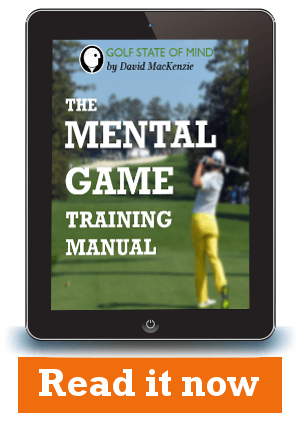I get hundreds (if not thousands) of search queries each week for “what are the best swing thoughts for golf?” and I can understand why. It’s certainly true that where you put your focus before and during a golf shot has a big effect on the consistency of your execution, no matter what level of player you are.
Although I can (and will) give you some mental game coaching on this, I’d like you to first ask yourself the question: “Where is my focus during the moments before and during a shot when I am playing my best golf?” Try to think back and try to pin-point it.
The reason I ask this is because there is no “best swing thought” that fits all players. It all depends on your ability and your personality type.
It’s true that most of the best players in the world aren’t thinking about much at all during their swings. They’re simply looking at the target, visualizing a shot shape and trusting themselves to hit the shot. They’ve ingrained every possible type of shot into their subconscious minds (through effective practice), which can be accessed on demand in any situation.
Tour players talk about the importance of visualization for golf, as it basically tells them how they are going to move their body during their swing (without necessarily thinking about it). Tiger once said that even when he’s looking down at ball before a shot, he can still see the target and the shape of the shot he wants to hit in his mind’s eye.
Due the pressure they play under, Tour players wouldn’t want technical reminders. With players of this level of ability, I typically work with them on ways to reach a place of calm, focus and confidence before a shot (a state where they are predominantly right brain active), so they can access the movement they need to during the 2 seconds of the golf swing.
As a general rule…
At this point I should (briefly) talk about Professor Gabrielle Wulf’s work on focus during athletic movement. You might have heard of the terms “internal and external focus” where internal focus is focusing on the body movement itself, vs external focus, which is focusing on the effect the movement. Wulf’s studies found that for any level of player, focusing just on the movement itself constrains the motor system and the automatic process (subconscious control) which inhibits performance. Wulf concluded that performance is better for players that are focused on either the target/trajectory of the shot or the effect of the swing, which might be the path and angle of the club-face as it makes contact with the ball.
I’ve spoken with many Tour players about the issue of the best swing thoughts for golf, and certainly, their swings are mostly subconsciously controlled (without thinking).
However, most will include a simple “swing key” which might help prevent a tendency under pressure. This could be a thought to keep the tempo smooth, such as counting or a thinking about piece of music. Focusing on the take-away is also a common one – this part of the swing can affect the tempo for the entire swing. If the club goes too quick back from the ball (a common issue under pressure), the rest of the swing will be quick and out of sync. It needs to be smooth and relatively slow. Focusing on the take-away is also important in making sure the swing is wide, so there is enough lag in the swing to get the club coming on an inside path on the downswing. You could argue these are movement (internal) focused, but if a player has tried many things and statistically they play better when they think of one thing vs another, then who is to tell them any different? A more external focus example is to focus on the contact with the ball: Hunter Mahan says he focuses on hitting the inside-right quadrant of the ball, which encourages him to swing from the inside on the down-swing.
I’m going to return now to the question of “what were you thinking when you were playing well?” (which is why I think you should keep a “success log” after every round and practice session. Edufii.com is what I use with my students). Were they any particular thoughts or triggers that may have helped in that great performance? We are all different in the things we respond to and help us make a good swing. For those of us that are more “verbal” you might want to use something called a “Performance Statement”, which are trigger words that can help produce the same swing you do when you’re playing your best.
My advice to you is to experiment with various things and try to identity patterns in your play. Stay clear of anything too technical and keep it simple! If you’d like more suggestions for triggers and swing thoughts you can find them in my Golf State of Mind Training Program.

